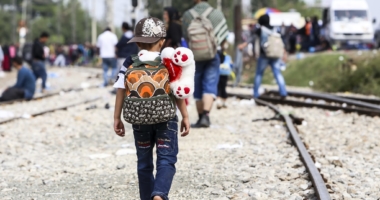“All Children are Born to Thrive”: Why Social, Emotional, and Academic Development (SEAD) Matters
After months of distance learning, unfinished instruction, social isolation, and missed activities during the summer months, many of the nation’s students will need extra support when the 2020-2021 school years starts. But will they get it?
Nancy Duchesneau is the lead researcher and author of Ed Trust’s latest report, Social, Emotional, and Academic Development Through an Equity Lens, in which she contends that in order for SEAD to be effective, school leaders must focus on how to support students’ needs through holistic social, emotional, and academic development instead of the singular focus on changing how students should think, behave, and feel. In this Q&A, Nancy talks about her research.
What is social, emotional, and academic development, or SEAD? What is it not?
Typically, the social-emotional aspects of schooling have been defined by competencies, including managing emotions and behavior, and believing in your ability to achieve goals. But in our paper I make a strong case on why there needs to be a shift in how leaders and educators think about social, emotional, and academic development. It’s not about controlling students’ behavior and telling them to believe in themselves. And it’s not about “fixing” students and molding them into what the American dominate norms dictates how students should act. It should be about whether the school system is creating a learning environment that is respectful of all cultural backgrounds, equitably supports holistic development, and is responsive to what each individual student needs.
For this research, we wanted to be informed by the authentic experiences of students most impacted by inequitable SEAD. The students and families I spoke with would talk about systemic racism, and how without addressing that first, telling students of color to “control themselves” places the burden back on marginalized communities to accept marginalization with a smile.
What are some of the misconceptions that people have about SEAD? 90% of schools and districts report to be working on it, but it doesn’t seem clear as to what it’s supposed to be about.
Yes, in far too many places most of this “work” has solely focused on changing student behavior and mindset rather than implementing practices that build relationships and create learning environments that support positive social and emotional growth. And this is especially true for schools and districts that serve large populations of students of color and those from low-income backgrounds. In this particular study, when we asked what the school is doing, the responses ranged from pullout programs to get students to behave a particular way, all the way up to school-wide approaches that try to build stronger relationships between staff and the students. The latter is better, but it’s not quite enough. School leaders and educators need think about everything through an equity lens, and even think about the policies they have in place, does it match their core values as supporting students’ growth? There are three components to social-emotional and academic development that we highlight in the report:
- Foster student belonging
- Challenge all students to thrive
- Provide the academic and holistic supports students need
As with everything, it comes down to how they are implemented, that schools are doing it through an equity lens, and that schools are recognizing that students experience school in different ways.
Why is social-emotional and academic development especially important during this COVID-19 crisis?
It’s become very clear that COVID-19 has been shining a light on inequities, and even exacerbating those inequities. All children are born to thrive. And right now, there are students of color and students from low-income households stepping up in their families and in their communities — from taking on caretaking duties for siblings and family members to becoming more active in protests against police brutality and racial injustice— on top of their studies. Some are experiencing hardship, such as losing family members to the coronavirus and dealing with family members who may have lost their jobs. With all that strength and resilience, students need school leaders and educators to recognize and foster those things, but oftentimes, the opposite is happening.
That means that educators will need to do some work on themselves, starting with the belief that ALL their students can thrive. Having an asset-based mindset, so they see the potential rather than the deficit. Realizing that these skills are displayed in a multitude of ways, and just because students may not show them the way dominant norms expect, doesn’t mean they’re not socially and emotionally competent.
What were some of the themes from talking to students and families?
Two really important takeaways from those conversations come to mind: One is how critical racial identity is to the core of social-emotional development. Family members often spoke about how students of color need to learn to “love within” and know their backgrounds and cultures. A second takeaway is that students of color often already have advanced social-emotional skills and mindsets, but they’re not being recognized for it. The students I spoke to were incredibly self-aware, especially with regard to the roles race and ethnicity play in their lives, and how the systemic racism they see influences their emotions, leading them to self-advocate in impressive ways. But these students often spoke of being shut down, being ignored or dismissed when they self-advocate, and even seeing other students of color punished for it.
I remember one brilliant young lady who spoke of seeing teachers in her school differ in how they responded to students along “racial and socioeconomic lines, because that’s just how this works.” Even with small requests, like permission to go somewhere or do something, she said, students of color were less likely to be granted.
I think these themes are going to be so important for school leaders and educators to understand this coming school year, when students will be much more aware of systemic injustices and students of color are more likely to have experienced these injustices firsthand. They’ll be more aware of their racial identities, and they’ll need to advocate for themselves in a time when schools have fewer resources, and those need to be seen as positive things that educators foster rather than shut down.
During this pandemic and for however long schools use distance learning, how can advocates make sure that kids are getting their social, emotional, and academic development needs met?
In the current situation, it certainly means that advocates need to be more vigilant. Some schools will be in person, some online, some hybrid, but the core tenets still apply: Students need to feel like they belong, that they’re being challenged to thrive, and that they have the academic, emotional, and holistic supports that they need in order to thrive. The work needed to fundamentally change schools to support better SEAD will not happen overnight, or even in a single year.
Superintendents, principals, and teachers will come and go — ideally not often, but, of course, churn happens — but advocates are invested in their communities. When advocates are there for the long haul, they can make sure schools stay the course when the folks in schools change. Advocates can hold schools, school leaders, and educators accountable, for continuing to improve learning conditions and environments for their students.
What do you want readers to take away from this report?
When we think about social, emotional, and academic development, it’s not just teaching life skills; it’s about making sure that we as the adults are providing the supports that students need to grow into competent, confident, happy adults. I want us, in the education sphere, to move away from teaching these skills and really think about everything from policy to practice to mindsets the adults have and how all of those things impact students growing and developing. Instead of thinking about social-emotional learning as skill building, we need to recognize that learning is social and emotional, and that when schools marginalize students, we harm not just their social-emotional well-being, but their academic learning as well.
In the report, we offer six main recommendations, designed for the district level, but they could also apply to state and federal policies:
- Provide meaningful professional development
- Diversify the leadership and teaching workforce
- Ensure equitable access to and supports for success in rigorous and culturally sustaining coursework
- Ensure inclusive discipline and dress code policies
- Ensure access to integrated wraparound services and supports
- Engage parents and students and communities as full partners
Most critical, and my favorite, is engaging students and families as full partners, because nothing can be looked at with an equity lens without their input – Everything that happens in a school building, parents and students should have a say — especially Black and Latino and low-income families.








